
Related
Fifty years ago today, just after midnight, at 1:30 in the morning on June 28, 1969, New York City police officers raided a gay- and trans-friendly bar called the Stonewall Inn on Christopher Street in Greenwich Village. As the police began dragging some of the patrons out, the community fought back, sparking three days of rioting. Their historic resistance launched the modern-day LGBTQ movement and became known as the Stonewall uprising. We hear the leaders of the Stonewall uprising in their own words, in a radio documentary produced by Dave Isay in 1989 called “Remembering Stonewall.”
Transcript
AMY GOODMAN: This is Democracy Now! I’m Amy Goodman. Fifty years ago today, it was just after midnight, at 1:30 in the morning of June 28th, 1969, New York City police officers raided a gay- and trans-friendly bar called the Stonewall Inn on Christopher Street in Greenwich Village. As the police began dragging some of the patrons out, the community fought back, sparking three days of rioting. The historic resistance launched the modern-day LGBTQ movement; that became known as the Stonewall uprising.
We turn today to some of the original voices of those people who led the uprising, this documentary produced by Dave Isay in 1989, Remembering Stonewall.
GEANNE HARWOOD: I am Geanne Harwood, and my age is 80.
BRUCE MERROW: I’m Bruce Merrow.
GEANNE HARWOOD: I don’t know if it’s really true, but now people do refer to us as the two oldest gay men in America. We do, I think, have maybe a record relationship of almost 60 years together. Being gay before Stonewall was a very difficult proposition, because we felt that in order to survive, we had to try to look and act as rugged and manly as possible to get by in the society that was really very much against us.
RANDY WICKER: My name is Randy Wicker. I was the first openly gay person to appear on radio in 1962 and on television in 1964 as a self-identified homosexual. In the era before Stonewall, people felt a need to hide because of the precarious legal position they were in. They would lose their jobs. There was a great hostility, socially speaking, in the sense if people found out you were gay, they assumed you were a communist or a child molester or any of another dozen stereotypes that were rampant in the public media at the time.
JHERI FAIRE: I’m Jheri Faire, and I’m 80 years old. I started a gay lifestyle in 1948 when I was around 39 or 40. At that time, if there was even a suspicion that you were a lesbian, you were fired from your job, and you were in such a position of disgrace that you slunk out without saying goodbye even to the people that liked you and you liked, never even bothered to clean your desk. You just disappeared. You just disappeared. You went quietly, because you were afraid that the recriminations that would come if you even stood there and protested would be worse than just leaving.
SYLVIA RIVERA: My name is Sylvia Rivera. My name before that was Ray Rivera, until I started dressing in drag in 1961. The era before Stonewall was a hard era. There was always the gay bashings on the drag queens by heterosexual men, women and the police. We learned to live with it, because it was part of the lifestyle at that time, I guess. But none of us were very happy about it.
SEYMOUR PINE: My name is Seymour Pine. In 1968, I was assigned as deputy inspector in charge of public morals in the first division in the police department, which covered the Greenwich Village area. It was the duty of public morals to enforce all laws concerning vice and gambling, including prostitution, narcotics, and laws and regulations concerning homosexuality. The part of the penal code which applied to drag queens was Section 240.35, Section 4: “Being masked or in any manner disguised by unusual or unnatural attire or facial alteration; loiters, remains, or congregates in a public place with other persons so masked…”
SYLVIA RIVERA: At that time, we lived at the Arista Hotel. We used to sit around, just try to figure out when this harassment would come to an end. And we would always dream that one day it would come to an end. And we prayed and we looked for it. We wanted to be human beings.
DAVE ISAY: On Friday evening, June 27th, 1969, at about 11:45, eight officers from New York City’s public morals squad loaded into four unmarked police cars and headed to the Stonewall Inn here at 7th Avenue and Christopher Street. The local precinct had just received a new commanding officer, who kicked off his tenure by initiating a series of raids on gay bars. The Stonewall was an inviting target. Operated by the Gambino crime family without a liquor license, the dance bar drew a crowd of drag queens, hustlers and minors. A number of the bar’s patrons had spent the early part of the day outside the Frank Campbell Funeral Home, where Judy Garland’s funeral was held. She had died the Sunday before. It was almost precisely at midnight that the morals squad pulled up to the Stonewall Inn, led by Deputy Inspector Seymour Pine.
SEYMOUR PINE: There was never any reason to feel that anything of any unusual situation would occur that night.
SYLVIA RIVERA: You could actually feel it in the air. You really could. I guess Judy Garland’s death just really helped us really hit the fan.
SEYMOUR PINE: For some reason, things were different this night. As we were bringing the prisoners out, they were resisting.
SYLVIA RIVERA: People started gathering in front of the Sheridan Square Park right across the street from Stonewall. People were upset. “No, we’re not going to go!” And people started screaming and hollering.
SEYMOUR PINE: One drag queen, as we put her in the car, opened the door on the other side and jumped out, at which time we had to chase that person. And he was caught, put back into the car. He made another attempt to get out the same door—the other door. And at that point we had to handcuff the—the person. From this point on, things really began to get crazy.
ROBERT RIVERA: My name is Robert Rivera, and my nickname is Birdy, and I’ve been cross-dressing all of my life. I remember the night of the riots, the police were escorting the queens out of the bar and into the paddy wagon. And there was this one particularly outrageously beautiful queen with stacks and stacks of Elizabeth-style, Elizabeth Taylor-style hair, and she was asking them not to push her. And they continued to push her, and she turned around, and she mashed the cop with her high heel. She knocked him down, and then she proceeded to frisk him for her—the keys to the handcuffs that were on her. She got them, and she undid herself and passed them to another queen that was behind her.
SEYMOUR PINE: Well, that’s when all hell broke loose at that point. And then we had to get back into the Stonewall.
MARTIN BOYCE: My name is Martin Boyce, and in 1969 I was a drag queen known as Miss Martin. I remember on that night, when we saw the riot police, all of us drag queens, we linked arms like the Rockettes and sang this song we used to sing: “We are the Village girls, we wear our hair in curls. We wear our dungarees above our nellie knees.” And the police went crazy hearing that, and they just immediately rushed us. We gave one kick and fled.
RUDY: My name is Rudy, and the night of the Stonewall I was 18. And to tell you the truth, that night I was doing more running than fighting. I remember looking back from 10th Street, and there on Waverly Street there was a police, I believe on his—a cop, and he’s on his stomach in his tactical uniform and his helmet and everything else, with a drag queen straddling him. She was beating the hell out of him with her shoe. Whether it was a high heel or not, I don’t know. But she was beating the hell out of him. It was hysterical.
MAMA JEAN: My name is Mama Jean. I’m a lesbian. I remember on that night I was in a gay bar, a woman’s bar, called Cookies. We were coming out of the gay bar, going toward Eighth Street, and that’s when we saw everything happening, blasting away—people getting beat up; police coming from every direction, hitting women as well as men with their nightsticks; gay men running down the street with blood all over their face. We decided right then and there—whether we’re scared or not, we didn’t think about it—we just jumped in.
SYLVIA RIVERA: Here, this queen is going completely bananas, you know, jumping on, hitting the windshield. The next thing you know, the taxicab was being turned over, the cars were being turned over, things—windows were shattering all over the place, fires were burning around the place. It was beautiful. It really was. It was really beautiful.
MAMA JEAN: I remember one cop coming at me, hitting me with the nightstick on the back of my legs. I broke loose, and I went after him. I grabbed his nightstick. My girlfriend went behind him. She was a strong son of a gun. I wanted him to feel the same pain I felt. And I kept on saying to him, “How do you like the pain? Do you like it? Do you like it?” And I kept on hitting him and hitting him. I was angry. I wanted to kill him. At that particular minute, I wanted to kill him.
SYLVIA RIVERA: I wanted to do every destructive thing that I could think of at that time to hurt anyone that had hurt us through the years.
MAMA JEAN: It’s like just when you see a man protecting his own life. They weren’t the “queens” that people call them; they were men fighting for their lives. And I’d fight alongside them any day, no matter how old I was.
SYLVIA RIVERA: A lot of heads were bashed that night. A lot of people were hurt. But it didn’t hurt their true feelings. They all came back for more and more. Nothing—that’s when you could tell that nothing could stop us at that time or at any time in the future.
GEANNE HARWOOD: When Stonewall happened, Bruce and I were still in the closet, where we had been for nearly 40 years. But we realized that this was a tremendous thing that had happened at Stonewall, and it gave us a feeling that we were not going to be remaining closeted for very much longer. And soon thereafter, we did come out of the closet.
GINNY APUZZO: My name is Ginny Apuzzo. In 1969, I was in the convent. And when Stonewall hit the press, it hit me with a bolt of lightning. It was as if I had an incredible release of my own outrage at having to sequester so much of my life. I made my way down. I seem to recall in subsequent nights being down on the, you know, kind of just on the periphery, looking. Observer. Clearly an observer. Clearly longing to have that courage to come out. And it was a matter—as I recall, it was only a matter of weeks before I left the convent and started a new life.
HENRY BAIRD: I’m Henry Baird. In 1969, I was in the U.S. Army, a specialist three stationed at Long Bend Post near Saigon in Vietnam. I remember I was having lunch in the Army mess, reading the armed forces news summary of the day, and there was a short paragraph describing a riot led by homosexuals in Greenwich Village against the police. And my heart was filled with joy. I thought about what I had read frequently, but I had no one to discuss it with. And secretly within myself, I decided that when I came back stateside, if I should survive to come back stateside, I would come out as a gay person. And I did.
SEYMOUR PINE: For those of us in public morals, after the Stonewall incident, things were completely changed from what they had previously been. They suddenly were not submissive anymore. They now suddenly had gained a new type of courage. And it seemed as if they didn’t care anymore about whether their identities were made known. We were now dealing with human beings.
SYLVIA RIVERA: Today I’m a 38-year-old drag queen. I can keep my long hair, I can pluck my eyebrows, and I can work wherever the hell I want. And I’m not going to change for anybody. If I change, then I feel that I’m losing what 1969 brought into my life. And that was to be totally free.
AMY GOODMAN: And that last voice, Sylvia Rivera, in the documentary Remembering Stonewall, produced in 1999 by Dave Isay and Michael Schirker. Today marks the 50th anniversary of the Stonewall uprising. It began just after midnight tonight, 50 years ago, in Greenwich Village and launched the modern-day LGBTQ movement.
That does it for our show. Special thanks to Charina Nadura. I’m Amy Goodman. Thanks for joining us.

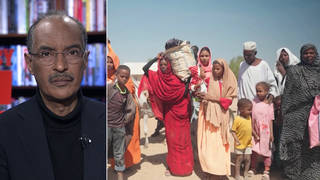
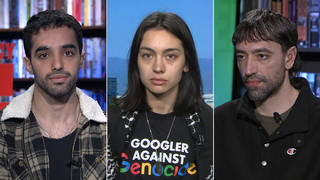

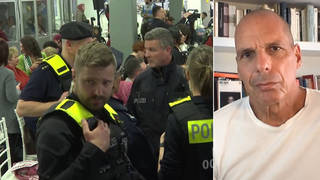





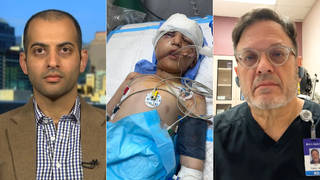
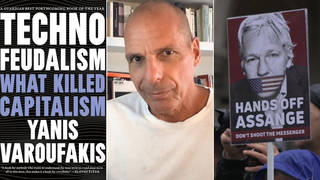
Media Options